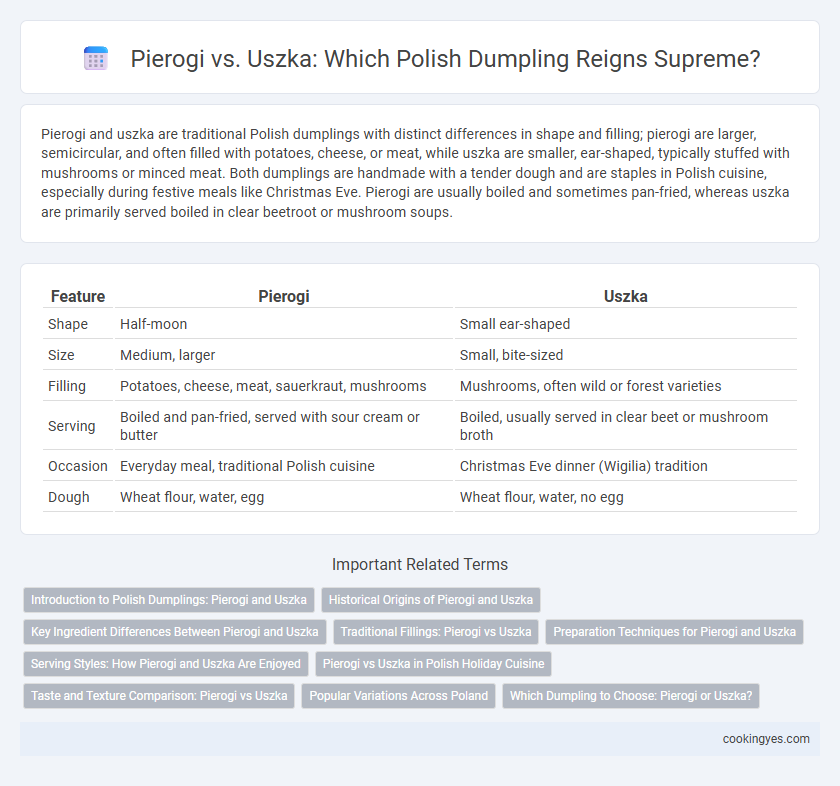Pierogi and uszka are traditional Polish dumplings with distinct differences in shape and filling; pierogi are larger, semicircular, and often filled with potatoes, cheese, or meat, while uszka are smaller, ear-shaped, typically stuffed with mushrooms or minced meat. Both dumplings are handmade with a tender dough and are staples in Polish cuisine, especially during festive meals like Christmas Eve. Pierogi are usually boiled and sometimes pan-fried, whereas uszka are primarily served boiled in clear beetroot or mushroom soups.
Table of Comparison
| Feature | Pierogi | Uszka |
|---|---|---|
| Shape | Half-moon | Small ear-shaped |
| Size | Medium, larger | Small, bite-sized |
| Filling | Potatoes, cheese, meat, sauerkraut, mushrooms | Mushrooms, often wild or forest varieties |
| Serving | Boiled and pan-fried, served with sour cream or butter | Boiled, usually served in clear beet or mushroom broth |
| Occasion | Everyday meal, traditional Polish cuisine | Christmas Eve dinner (Wigilia) tradition |
| Dough | Wheat flour, water, egg | Wheat flour, water, no egg |
Introduction to Polish Dumplings: Pierogi and Uszka
Pierogi and Uszka are iconic Polish dumplings with distinct shapes and fillings, reflecting regional culinary traditions. Pierogi typically feature a semicircular shape filled with ingredients like potatoes, cheese, mushrooms, or meat, while Uszka are smaller, ear-shaped dumplings mainly stuffed with seasoned mushrooms or minced meat. Both varieties are integral to Polish cuisine, often served boiled or fried, and hold special significance during festive meals such as Christmas Eve.
Historical Origins of Pierogi and Uszka
Pierogi, with roots tracing back to the medieval Kingdom of Poland, evolved from Eastern European dumpling traditions and were historically filled with ingredients like potatoes, cheese, and sauerkraut. Uszka, smaller and crescent-shaped, originated as a delicate accompaniment to traditional Polish Christmas Eve beetroot soup (barszcz), typically filled with mushrooms or minced meat. Both dumplings reflect Poland's culinary adaptation of Slavic and Central European influences, preserving rich cultural significance in festive and everyday meals.
Key Ingredient Differences Between Pierogi and Uszka
Pierogi dough is typically made with flour, water, and eggs, resulting in a pliable, tender wrapper, while Uszka dough is thinner and often prepared without eggs to achieve a more delicate texture. Pierogi fillings commonly include potatoes, cheese, sauerkraut, or meat, emphasizing substantive and hearty flavors, whereas Uszka are traditionally stuffed with finely chopped mushrooms and onions, offering a savory and earthy profile. The distinct dough composition and contrasting fillings define the key ingredient differences that separate these iconic Polish dumplings.
Traditional Fillings: Pierogi vs Uszka
Pierogi typically feature traditional fillings like potato and cheese, sauerkraut with mushrooms, or sweet fruit such as blueberries, showcasing a variety of savory and sweet options. Uszka, smaller in size, are usually filled with finely chopped wild mushrooms and onions, reflecting their role as a delicate accompaniment to clear beetroot soup (barszcz). The difference in fillings highlights pierogi's versatility as a main dish compared to uszka's specialized function in Polish culinary tradition.
Preparation Techniques for Pierogi and Uszka
Pierogi dough is typically rolled thicker and filled with a variety of ingredients such as potatoes, cheese, or meat before being boiled or fried, creating a hearty texture. Uszka dough is thinner and more delicate, often filled with mushrooms or minced meat, then boiled and served in broth, enhancing their tender consistency. The distinct preparation techniques result in pierogi having a denser bite compared to the lighter, soup-friendly uszka.
Serving Styles: How Pierogi and Uszka Are Enjoyed
Pierogi are often served boiled or pan-fried, accompanied by toppings such as sour cream, fried onions, or bacon bits, enhancing their savory or sweet fillings. Uszka, smaller and typically filled with mushrooms or meat, are traditionally served in a clear beet or mushroom broth, especially during Christmas Eve dinner. Both dumplings highlight unique textures and flavors, with pierogi offering a hearty meal and uszka providing a delicate accompaniment in soups.
Pierogi vs Uszka in Polish Holiday Cuisine
Pierogi and Uszka are traditional Polish dumplings that play key roles in holiday cuisine, especially during Christmas Eve dinners. Pierogi are larger, semicircular dumplings typically filled with potatoes, cheese, or sauerkraut, whereas Uszka are smaller, ear-shaped dumplings often stuffed with wild mushrooms or minced meat. Both are essential to the festive table, with Pierogi usually served as a main dish and Uszka commonly accompanying beetroot soup (barszcz).
Taste and Texture Comparison: Pierogi vs Uszka
Pierogi feature a thicker, tender dough with a mildly chewy texture, often filled with savory ingredients like potatoes, cheese, or meat, providing a rich and hearty taste. Uszka, smaller and more delicate, boast a thin, silky dough that offers a light, smooth bite with fillings usually consisting of finely chopped mushrooms or seasoned meat, resulting in a more subtle, earthy flavor. The contrast in dough thickness and filling density makes pierogi more robust and filling, while uszka offer a refined, delicate mouthfeel ideal for accompanying clear broths or borscht.
Popular Variations Across Poland
Pierogi and Uszka are two beloved types of Polish dumplings with distinct regional popularity and fillings. Pierogi, typically larger and crescent-shaped, are commonly filled with ingredients like potato, cheese, mushrooms, or meat, and are especially popular in southern regions such as Lesser Poland. Uszka, much smaller and often served in barszcz (beet soup), are traditionally stuffed with wild mushrooms or minced meat and are a staple in eastern and central Poland during Christmas Eve celebrations.
Which Dumpling to Choose: Pierogi or Uszka?
Pierogi and Uszka are iconic Polish dumplings, each offering distinct textures and fillings that influence the choice based on culinary preference. Pierogi are typically larger, semi-circular with thicker dough, often stuffed with potatoes, cheese, meat, or fruits, making them versatile for savory or sweet dishes. Uszka, smaller and crescent-shaped, traditionally filled with mushrooms or minced meat, are best suited for pairing with clear borscht, emphasizing a delicate, refined dining experience.
Pierogi vs Uszka for Polish dumplings Infographic

 cookingyes.com
cookingyes.com